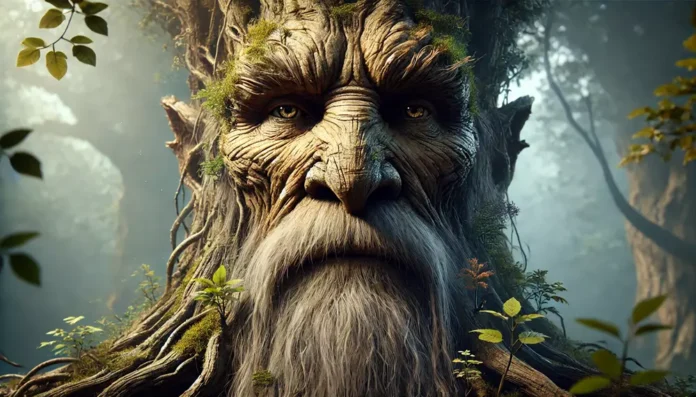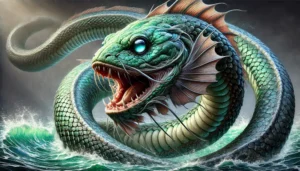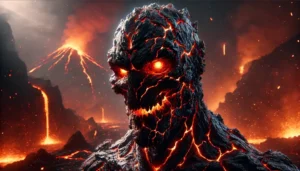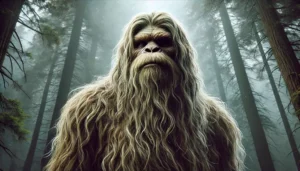Introduction
Ents are the ancient, tree-like beings created by J.R.R. Tolkien in The Lord of the Rings, serving as guardians of the forests in Middle-earth. Often referred to as “Tree Shepherds,” these sentient beings are notable for their strength, patience, and unwavering dedication to protecting nature.
Ents, led by Treebeard in The Two Towers, emerge as a powerful force resisting the destruction wrought by Saruman and his Orc armies. Their deep connection to nature and fierce response to its exploitation have made Ents enduring symbols of ecological preservation.
History and Origin
The Ents were first introduced in The Lord of the Rings (published between 1954 and 1955), though Tolkien had conceived of them earlier, inspired by Norse and Anglo-Saxon mythology. He coined the term “Ent” from the Old English word ent, meaning “giant.” The Ents are best described in The Two Towers, where Treebeard, the oldest of the Ents, leads his kin in a march against Saruman’s forces to defend Fangorn Forest.
Tolkien wrote in a letter about the Ents, saying: “They represent, I suppose, the ‘voice of nature’—all that is left, from our human viewpoint, of ancient and pristine life; and they have survived in part because they have withdrawn themselves” (The Letters of J.R.R. Tolkien, Letter #339). In this sense, Ents embody nature’s enduring, often silent strength and its capacity for rage when threatened.
Name Meaning
The term “Ent” has its roots in Old English, meaning “giant,” a term found in texts Tolkien studied as a professor. The Old English word appears in Beowulf and other early literature to describe giant beings. In Middle-earth, Tolkien applies this term to denote the Ents as towering, sentient trees with immense strength. The Elvish name for Ents, Onodrim, meaning “tree-people” in Sindarin, further emphasizes their mystical connection to the forest.
Background Story
In Tolkien’s mythology, Ents were created by the Vala Yavanna, the goddess of growth, as protectors of trees. In The Silmarillion, Yavanna says, “Would that the trees might speak on behalf of all things that have roots, and rise against the axes of the despoilers.” This creation myth establishes the Ents as nature’s guardians, endowed with the power to act on behalf of all living things unable to defend themselves.
In The Two Towers, Tolkien describes Treebeard’s sorrow and anger at Saruman’s devastation of Fangorn Forest: “There is no curse in Elvish, Entish, or the tongues of Men for this treachery. My heart is broken.” This line captures Treebeard’s grief and foreshadows the Ents’ determined march against Saruman, a dramatic example of nature retaliating against industrial destruction.
The Ents’ “Last March” symbolizes nature’s wrath when exploited, as Treebeard leads the Ents in an assault on Isengard. In Tolkien’s words, “I am not altogether on anybody’s side, because nobody is altogether on my side, if you understand me; nobody cares for the woods as I care for them” (The Two Towers, Book III, Chapter 4). This statement reveals the Ents’ profound loyalty to the forest and indifference to the conflicts of Men, Elves, or Dwarves, focusing instead on the preservation of their domain.
Cultural Impact
Ents have resonated deeply in modern culture as symbols of ecological preservation, and they have influenced environmentalist thought as well as other creative works.
Environmentalism
Treebeard’s line, “There is no curse in Elvish, Entish, or the tongues of Men for this treachery,” has become emblematic of environmentalist movements worldwide. Tolkien’s portrayal of Ents as protectors of nature has inspired organizations focused on tree conservation and forest protection. In particular, conservationists frequently reference the Ents to represent the struggle against deforestation and industrialization.
Literature
Tolkien’s Ents have inspired numerous depictions of tree spirits and guardians of nature in literature. For instance, C.S. Lewis, Tolkien’s contemporary, included sentient trees in The Chronicles of Narnia, which bear some resemblance to Ents. Although Narnia’s trees lack the Ents’ imposing presence, they reflect a shared belief in the inherent power of nature.
Music
The progressive rock band Rush alludes to the Ents in their song “The Trees,” which discusses the conflict between trees and an impending industrial threat. Although the song does not mention Ents directly, its thematic focus on the resilience of trees reflects Tolkien’s influence on popular culture and ecological awareness.
Cinema and Visual Adaptation
Peter Jackson’s film adaptation of The Lord of the Rings gave visual form to the Ents, particularly in the “Last March” scene where they assault Isengard. This portrayal reinforced the Ents’ role as powerful defenders of nature and showcased the grandeur and strength of Middle-earth’s forests.
Modern Activism and Eco-Spirituality
Ents are symbols in eco-spiritual movements that promote environmental preservation. For instance, the Green Man Festival, inspired by similar tree-spirits, celebrates art, music, and ecological awareness, echoing the Ents’ role as forest protectors.
Religion and Ritual
Although Ents are a product of Tolkien’s mythos, their symbolic role as protectors of nature resonates with ancient earth-centered beliefs. Trees and forests were revered as sacred in various pagan and animistic traditions, where nature spirits were believed to inhabit old trees. Neo-pagan groups today invoke figures like the Green Man, a forest spirit similar to Ents, in rituals aimed at celebrating or protecting nature. While not a literal figure in historical religion, the Ent embodies the spirit of these nature-focused beliefs, reinforcing humanity’s spiritual connection to trees and forests.
Scientific or Rational Explanations
From a rational perspective, Ents can be seen as representations of forest ecosystems, where every tree and plant is interdependent and resilient, enduring seasons of growth and decay. Their slow, measured actions mirror the natural progression of tree growth, which takes place on a vastly different timescale than human life. Tolkien’s decision to depict Ents as ancient, slow-moving beings reflects his own respect for the pace and permanence of natural landscapes, contrasting sharply with industrial progress.
Scholars have suggested that the Ents may represent Tolkien’s response to the rapid industrialization of his native England. Historian Patrick Curry argues, “The destruction of trees and the rise of industry are a clear influence on Tolkien’s mythology,” linking the Ents with Tolkien’s environmental concerns. In this way, Ents serve as a commentary on the environmental impact of modernization, embodying the balance and endurance of nature.
In Modern Culture
Ents have become a staple in modern culture, resonating with both Tolkien enthusiasts and those concerned with environmental preservation. Here are a few prominent examples:
Film and Adaptations
Peter Jackson’s The Lord of the Rings brought the Ents to life with groundbreaking visual effects, particularly in the climactic scenes where the Ents march against Isengard. The movie adaptation solidified the Ents’ iconic status and their symbolic fight to protect nature from industrial threats.
Environmental Campaigns
Various environmental campaigns have adopted the image of the Ents as defenders of the forest. Conservation organizations frequently use Treebeard’s words and imagery to advocate for reforestation and sustainable forest management, underscoring the relevance of Ents in contemporary ecological discussions.
Literature and Gaming
Ent-like beings appear in fantasy literature and video games, such as the Elder Scrolls series, where Spriggans protect forests, and World of Warcraft, which includes Treants. These modern adaptations of tree-guardians echo Tolkien’s creation and have expanded the archetype in popular culture.
Green Man Festival
The Green Man, a symbol similar to the Ents, has inspired an annual festival in Wales that celebrates environmental awareness, arts, and music. The festival invokes the spirit of forest guardianship that Ents represent, blending ecological advocacy with cultural celebration.
Gardening and Decor
Ent-like figures are popular in garden decor, with statues and planters often depicting faces made of bark and branches. These items symbolize protection of the home environment and reflect a continued fascination with the Ent archetype.
Tattoo Art
Ent-inspired tattoos are common among fans of Tolkien and those who feel a connection to nature. Ent tattoos often signify strength, endurance, and an appreciation for nature’s resilience, symbolizing the protective spirit of forests.
Conclusion
Ents encapsulate Tolkien’s reverence for nature and critique of industrialization. Through Treebeard and the Ents, Tolkien illustrates the power and wisdom of natural beings whose lives and perspective operate on a different timescale from humanity’s. Their “Last March” remains an iconic metaphor for the consequences of environmental exploitation, and Ents continue to inspire environmental consciousness and advocacy. The Ents’ story serves as a lasting reminder of the importance of safeguarding our natural world, blending ancient myth with a pressing modern message.










